Beautiful & Versatile 10-Color Palettes for Any Design

Key Takeaways
A 10 color palette strikes a nice middle ground between variety and cohesion so that your design remains fresh but not hectic. Give defined roles to colors for primary, secondary, accent, and backgrounds to construct hierarchy that functions cross interfaces and brands.
💫 Discover Your Complete Color Palette
Ready to discover all the colors that make you look radiant? Our comprehensive color analysis will reveal your complete personal palette - perfect for hair, makeup, and wardrobe decisions.
Build My Palette →Begin with 2-3 anchor colors, then add 2-3 neutrals, then layer 2-3 calls to action. Document semantic states such as success, warning, error and information to maintain consistent user feedback.
Start from a base color and use complementary or analogous schemes, then adjust with balanced proportions. Try out combinations on actual elements such as buttons, icons, backgrounds and type to validate hierarchy and contrast.
Utilize color contrast checking tools for WCAG adherence and don't use color as the sole indicator of information. Match color with icons, labels, or patterns so all can comprehend your point.
Make an easy cheat sheet with hex and rgb values, usage notes and examples in mockups. Export swatches as standard formats such as PNG, SVG, SCSS, or JSON so your team can implement them immediately.
It's important to match your color choices to the emotion you want to elicit and the environment where they will exist. Preview the palette on screens and physical materials, tweaking for lighting and materials to maintain the mood.
A 10 Color color palette is a carefully selected group of ten colors that play nicely together for clean, harmonious design in print and on screen.
I most often use it with a base, a contrast, a few accents plus light and dark neutrals for range. Designers employ it to maintain tone consistent, direct attention, and bolster accessibility.
In practice, good sets include brand needs, UI states, and data viz. Next, alternatives, applications, and advice to create your own.
📚 Recent Articles
The purpose of a ten color palette
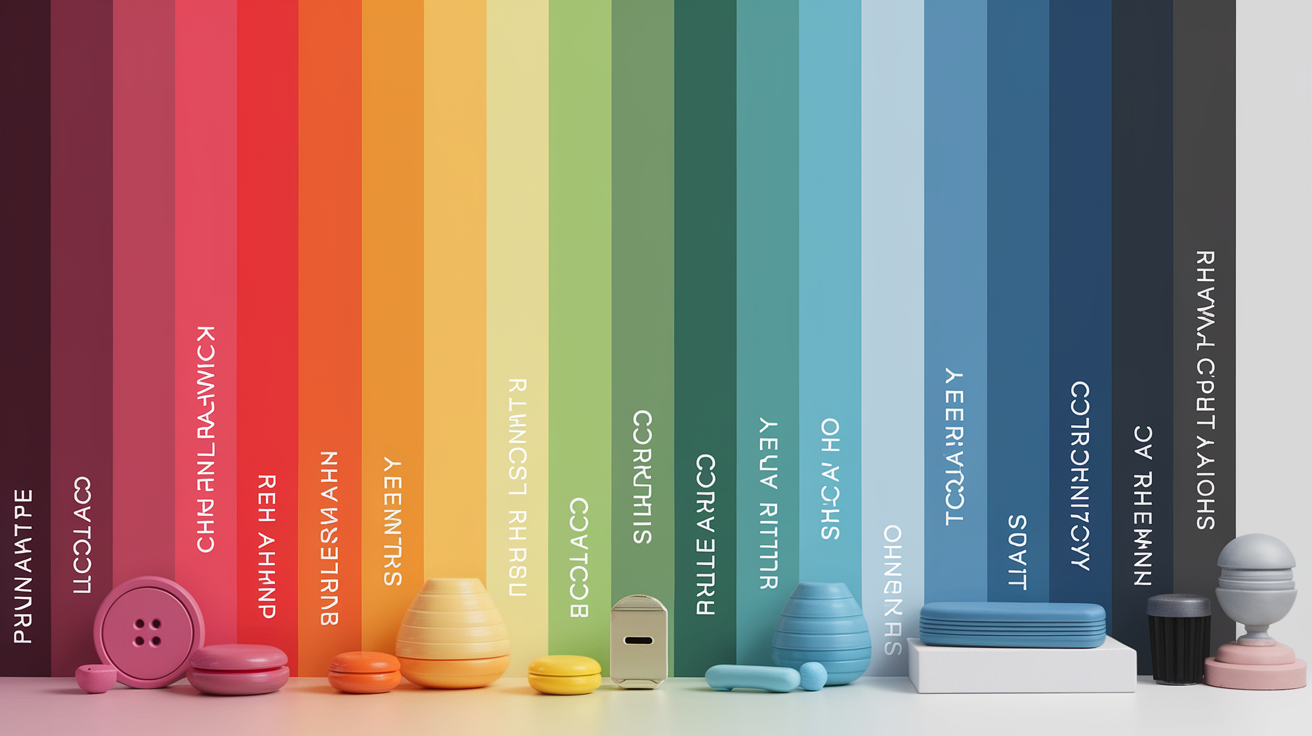
A ten color palette provides enough variation to create interest without sacrificing cohesion. It strikes a balance between selection and power. You can define explicit roles, enable rich layouts, and maintain a consistent brand tone across devices and platforms.
Clarify how a ten color palette provides enough variety for visual interest while maintaining design cohesion.
Ten colors that allow for play, yet still feel like one family. You can combine bright highlights with peaceful neutrals, and create contrast with tints and shades, but maintain a cohesive appearance. This plays nicely to the classics—dashboards, product suites, event graphics—where seven or fewer colors come up short.
It backs up infographic work, where multiple data groups require sharp labels and contrast. Studies reveal brands employ approximately 10.8 colors on average, so ten isn't a reach, a common, workable standard. The collection often mixes primary, secondary and neutral hues.
This mix helps tell a clear story: bold hues draw the eye, soft tones hold space, and neutrals tie it all together. When applied judiciously, it creates an exciting, energetic atmosphere sans confusion. When used indiscriminately, it can be overpowering, so experiment with your audience and ensure selections match the brand's worth and tone.
Emphasize the advantage of having dedicated colors for primary, secondary, accent, and background roles in user interfaces and branding.
Giving roles makes these ten colors into a system. One or two primaries take care of core actions and logos. Two to three secondaries back up charts, tabs and less important activities.
Two accents provide highlights, alerts or seasonal notes. Three to four neutrals span text, lines and surface layers. This map accelerates design work, reduces guesswork, and keeps screens consistent.
Tons keep away. Links print as links. States—hover, focus, error, success—skim quickly. In branding, this specificity aids memorability—when every touchpoint employs the same roles, the palette becomes like a visual language folks learn by sight.
Display how a ten color palette supports visual hierarchy and contrast
| Role | Use case | Contrast goal | Example pairing |
|---|---|---|---|
| Primary | Main actions, logo | High vs background | Deep blue on off-white |
| Secondary | Charts, tabs | Medium | Teal on light gray |
| Accent | Alerts, highlights | Very high | Red on pale sand |
| Neutral-dark | Body text | 7:1 vs light bg | Charcoal on white |
| Neutral-mid | Borders, icons | Subtle | Gray on off-white |
| Neutral-light | Surfaces | Low | Warm gray with dark text |
| Success | Status | High | Green on white |
| Warning | Status | High | Amber on white |
| Info | Tips | Medium-high | Indigo on pale blue |
| Background | Base layer | Supportive | Soft white under all |
Highlight the flexibility of ten-color palettes for adapting to different design elements, such as buttons, icons, backgrounds, and typography.
This count flexes over sections with no repeats. Tons can scale from primary fill to subtle ghost states. Icons can utilize secondary tones for context yet remain readable.
Backgrounds can change by layer — base, card, modal — so depth translates crisp. Type stays simple: one dark neutral for body, one mid neutral for hints, one accent for links.
For posters or social posts, rotate accents to keep feeds fresh yet aligned. For data-heavy screens, give each series a constant secondary, then use tints to indicate time or state.
The series backs inventive work and accurate messaging, and maintains brand signals strong over web, print and motion.
How to build your 10 color palette
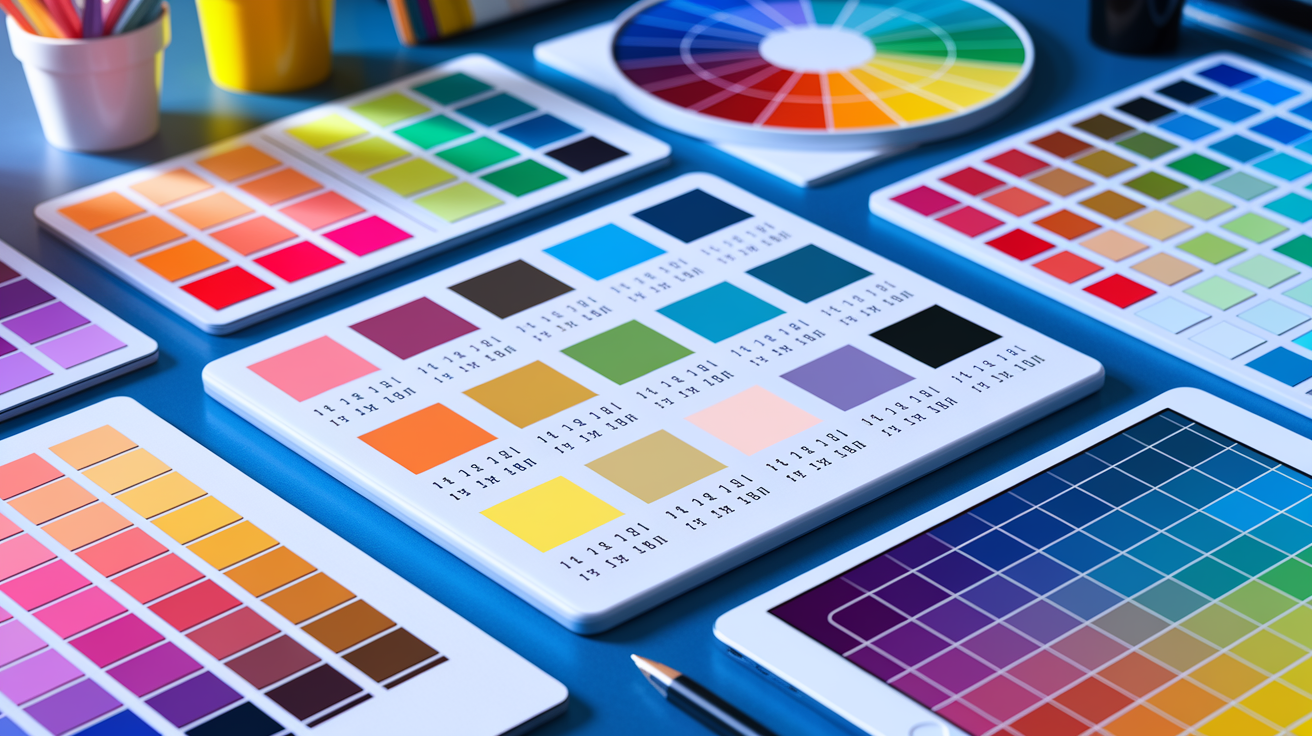
Begin with a single base shade that suits the mood and purpose, then branch out using color theory. Pull neighbors from the color wheel for analogous harmony, or select an opposite for a crisp complementary couple. Construct tints and shades by adjusting hue, saturation, and lightness a notch — an easy approach for 10 colors is 1 base, 4 tints, 4 shades, + 1 neutral.
Use the 60-30-10 rule to set ratios: 60% dominant, 30% secondary, 10% accents. Check contrast early so text and icons remain readable. For inspiration, test out a color picker or generator such as Adobe Color, or explore curated libraries, then customize.
1. Anchor colors
Choose 2–3 anchors that show your core voice: one primary, one secondary, and an optional alternative for dark or light modes. If you're working from one color, generate a regular, a lighter tint for air and a darker shade for shadow.
Map anchors to big surfaces: page backgrounds, nav bars, hero blocks, card fills. In practice, keep anchors inside the 60% and 30% slices so they set the scene. Strive for legibility. Match anchor backgrounds with high-contrast text + links.
Test wcag contrast on light/dark states. If contrast doesn't work, shift lightness before hue. Use anchors as the root for more steps: pull 3–4 supporting tints/shades and let accents sit on top.
2. Neutral tones
Select 2–3 neutrals—white, near-white, gray, charcoal, or black—to ground the collection and create white space, even on dark backgrounds. Use neutrals on body copy, surfaces, dividers and quiet UI zones.
They decelerate the gaze and allow color to direct significance. Blend a gentle gray in with strong colors to soften the din. Warm beiges can humanize a cold tech blue. Maintain a crisp neutral ladder for light and dark modes.
Maintain a good neutral-to-color balance. A lot of floor plans play nicely with 70–80% neutral surfaces.
3. Accent shades
Add 2–3 accents that work with your anchors—blue anchor with coral, lime, or gold accent. Pull them from complementary or split-complementary locations on the wheel. Accents for CTAs, links, data points, badges.
Restrict coverage to that 10% slice so highlights remain special. Verify contrast on light and dark backgrounds. If an accent is flimsy, increase saturation or adjust lightness. Rotate accents by role: one for action, one for info highlights, one for data peaks.
4. Semantic states
Assign colors to status: success green, warning yellow, error red, info blue. Keep them constant across screens so significance remains crisp. Check on different backgrounds, in different light, in grayscale previews — edge cases.
Record hex, RGB, roles and contrast notes in your guide for handoffs.
5. Final review
Browse for equilibrium, no one tone should hijack the spotlight on its own (unexpected). Preview in mockups, data charts and packaging. Tweak ratios, switch near neighbors and re-test contrast.
If stuck, sample 3–4 colors with one from each row—tint, regular, shade—to re-balance.
| Name | HEX | RGB | Usage |
|---|---|---|---|
| Base Blue | #2A6FE8 | 42,111,232 | Primary (60%), headers |
| Blue Tint 1 | #5A90F0 | 90,144,240 | Cards, hovers |
| Blue Tint 2 | #8AB0F6 | 138,176,246 | Background blocks |
| Blue shade 1 | #1D56B6 | 29,86,182 | Nav, highlight |
| Blue Shade 2 | #123C82 | 18,60,130 | Dark mode surfaces |
| Accent Coral | #FF6B5A | 255,107,90 | CTAs, alerts neutral |
| Accent Lime | #7ED957 | 126,217,87 | Positive badges |
| Info Blue | #2E90FF | 46,144,255 | Links, info state |
| Warning Yellow | #FFC53D | 255,197,61 | Warning state |
| Neutral Gray | #F2F4F7 | 242,244,247 | Background, borders |
Why accessibility matters in color
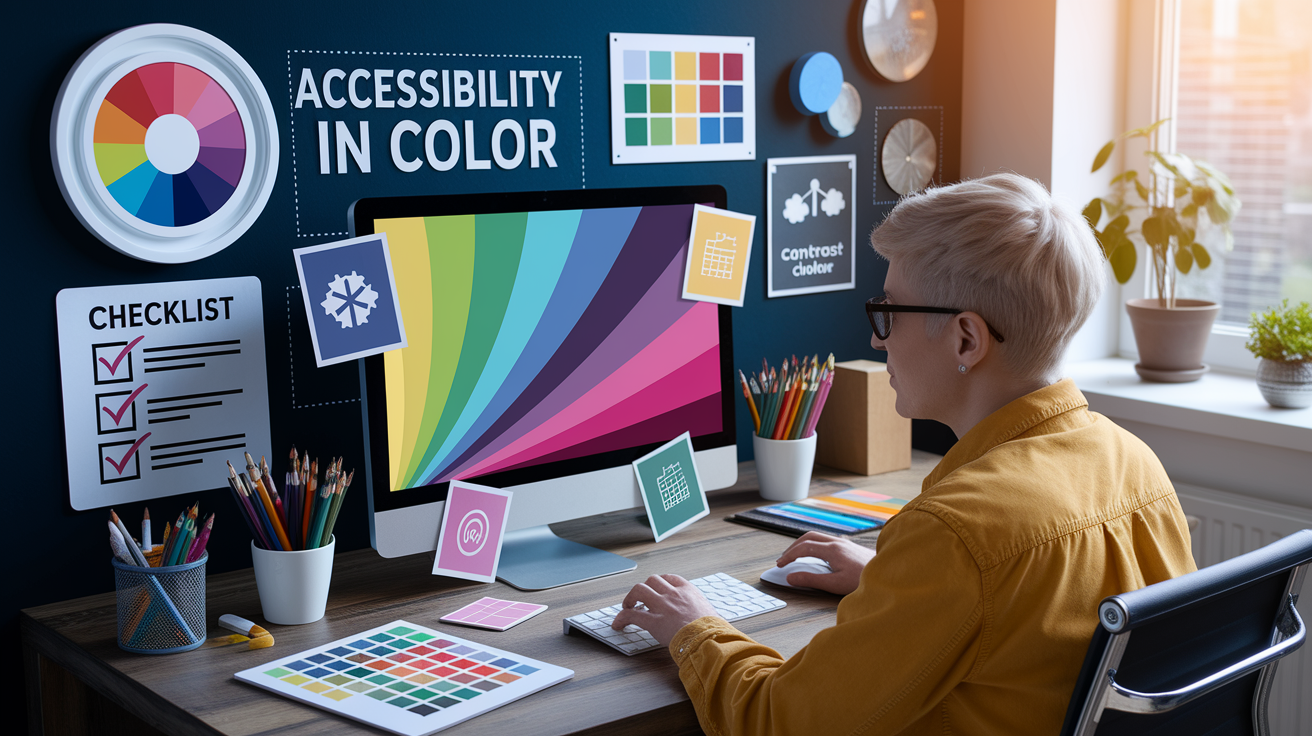
Color establishes mood and directs attention, but it can impede accessibility if not designed thoughtfully. A 10‑color palette provides variety, but that variety must remain accessible to the diverse array of eyes and screens.
Stress the importance of color contrast for users with visual impairments or color blindness.
Low contrast is the quickest path to losing readers. There are more than 2.2 billion people living with vision impairment, and approximately 5% of men have red–green color blindness that can cause red–green blends to be indistinguishable, or blue from purple at small size.
When normal text falls below a 4.5:1 contrast ratio, it blends into the background. Large text and icons can drop to 3:1, but body copy cannot. Pale gray on white, or soft blue on black, or green on red, may look great on a widescreen monitor, then fall apart on a tiny phone in sunlight.
There's the way color strikes mood and memory, and how gaudy colors can create strain. Save contrast for the core UI and content — then let decoration be softer.
Instruct on using tools to test color combinations for WCAG compliance and legibility.
Test before you ship. Use WCAG AA as the floor, and align with 508 where applicable. Run duos via contrast checkers such as WebAIM Contrast Checker, Stark, or Accessible Color Picker.
Verify live screens with browser dev tools to emulate vision types. Preview in both light and dark modes, on high-DPI and low-end screens. Verify states: default, hover, focus, active, disabled.
Print a sample in gray scale to test if meaning stays. Log pass/fail with ratios, not vibes.
Advocate for not relying solely on color to convey information; use patterns, icons, or text as well.
Color alone is dangerous. Approximately 4.5% of people have some color insensitivity, so a red error badge that only changes color can be missed.
Pair color with shape, icons, or text: a warning triangle plus "Error," a dotted outline for "draft," or striped bars for "in progress." On charts, include labels, solid and dashed lines, and separate marker shapes.
For forms, display inline text, icons, and distinct focus rings. This maintains legibility even if colors change or screens fade.
Create a checklist to highlight key accessibility considerations when designing with color.
- Lock WCAG AA contrast: 4.5:1 normal text; 3:1 large text/graphics.
- Test every pair in your 10‑color palette across states and modes.
- Provide non‑color cues: text labels, icons, patterns, line styles.
- Ensure focus indicators have strong contrast and clear shape.
- Label pie lines and slices; don't just depend on legends.
- Avoid red–green and blue–purple as sole contrasts.
- Check in gray scale and with color‑blind simulators.
- Document tokens (text, background, border, states) with ratios.
- Train teams; review designs to reduce legal and UX risk.
- Iterate with user feedback to improve equity and inclusion.
Examples of a 10 color palette
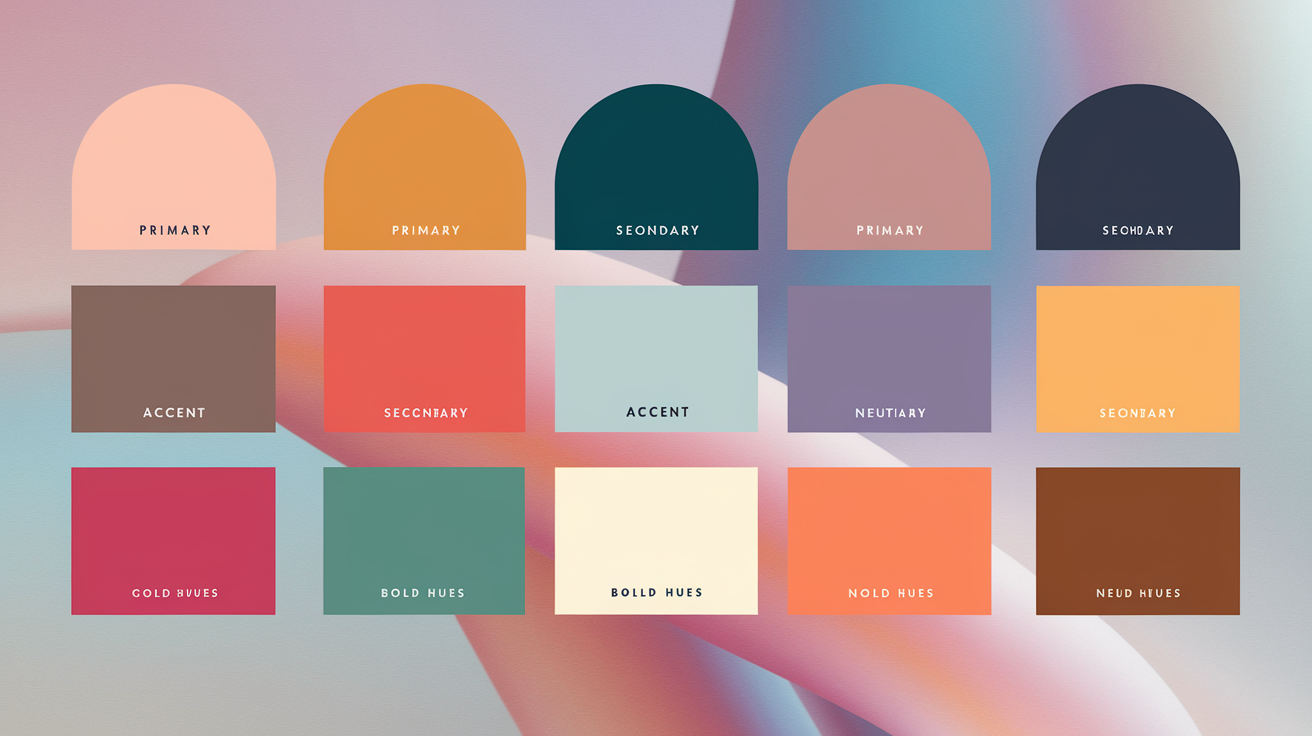
Clean architecture assists when you select ten colors. Think in roles: base tones for background and type, primary colors for brand or core UI, secondary colors for depth and variety, and accents for calls to action. Then tweak lightness and warmth to suit the mood.
- Balanced Brand Set: midnight blue, cobalt, sky, teal, mint, warm gray 90, warm gray 60, sand, coral, lemon.
- Calm Pastel UI: cloud white, powder blue, seafoam, lilac, blush, butter, soft gray, mist, pebble, tea green.
- ink black, fire red, saffron, royal blue, jade, violet, cream, stone, copper, electric cyan.
- Nature Greens: pine, moss, fern, olive, sage, mint, bark, loam, fog gray, dew.
- Warm Earth: terracotta, clay, rust, ocher, mustard, olive, cocoa, taupe, bone, charcoal.
- Cool Tech: slate, steel, graphite, ice, cyan, azure, indigo, silver, smoke, neon lime.
- Festive Contrast: cherry, tangerine, marigold, lime, aqua, azure, iris, magenta, pearl, ash.
- Monochrome Plus: black, near-black, dark gray, mid gray, light gray, off-white, plus accents—emerald, amber, cobalt, fuchsia.
- Sunset Spectrum: deep plum, berry, coral, apricot, peach, sand, haze, dusk blue, navy, ink.
- High-Contrast Accessibility: black, white, dark navy, deep green, maroon, bright yellow, vivid orange, cyan, royal purple, slate.
What to mix and why: primary choices (blue, red, yellow) give strong anchors, secondary hues (green, orange, purple) add range, while neutrals (white, black, gray, sand, taupe) keep layouts clean. Accents — coral, cyan or neon lime — lead the eye and emphasize crucial steps.
Where this works: brand systems, dashboards, data charts, packaging, and social posts. How to adapt: pick 2–3 base neutrals, 2 primaries for hierarchy, 3–4 secondaries for variety, and 1–2 accents with high contrast for CTAs. Test each against dark and light backgrounds to check legibility at 4.5:1 contrast or higher.
Mood slides with saturation and value. Pastels pair well with calm apps, wellness, or education — they maintain content focus and visual noise is minimized. Bright colors fit events, sports, or news; they invigorate and aid scan modules quickly.
Earth tones work for travel, food, or craft — they feel grounded and warm. Cool tech sets feel crisp for fintech or SaaS, plus they scale nicely across screens. Include at least two neutrals in every combination to prevent color overload.
How to use fast: export swatches in common formats for design and code handoff. Available downloads: PNG palettes for mood boards, SVG tiles for vector use, SCSS maps with variable names, and JSON arrays for tokens, theming, or chart libraries.
The emotional resonance of color
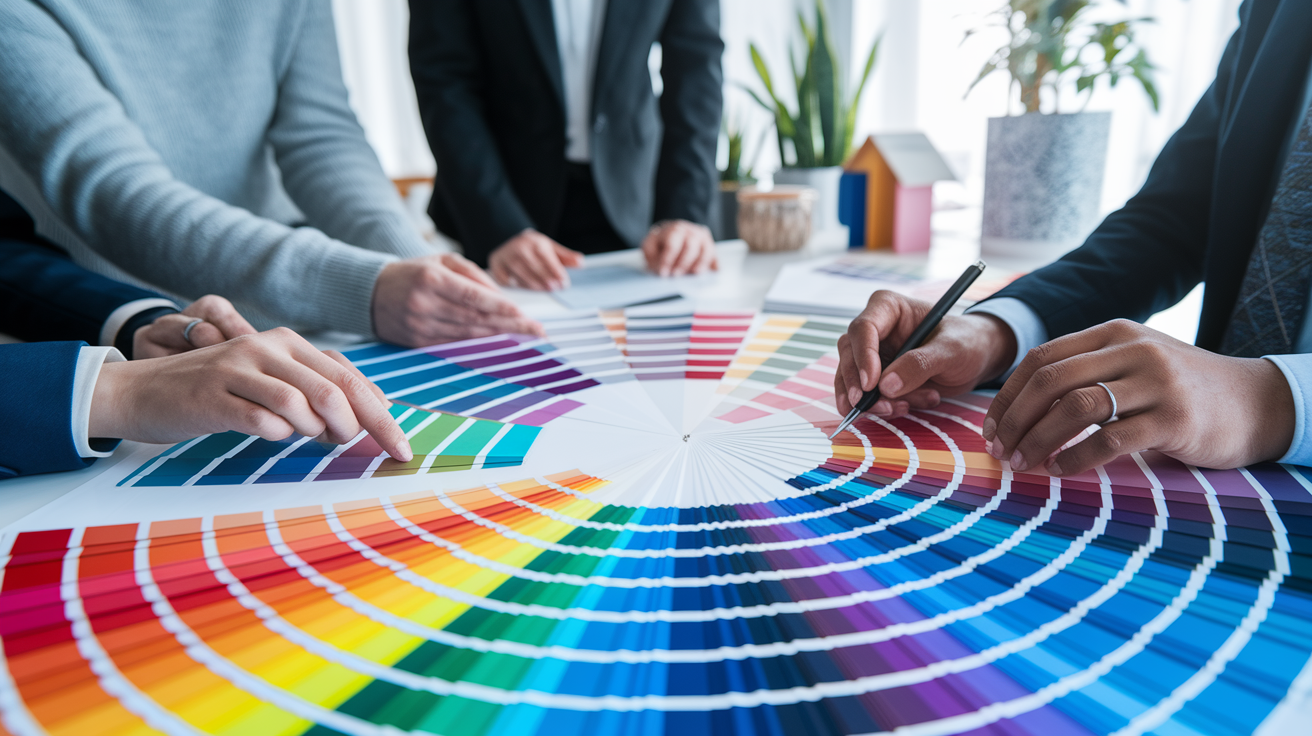
Color influences the way we feel and interpret meaning in a 10-color palette. This isn't novel. Goethe wrote of the mood of hues in the 19th century, and artists like Kandinsky linked color to spirit and mind. Modern research continues to pile on evidence. One big study on "Color Compatibility From Large Datasets" discovered that most people like warm bright colors and cyan, which suggests why some palettes seem welcoming and expressive and others feel dense or cold.
Blue, being a very popular color in marketing, tends to evoke feelings of trust, calm and clarity. It plays great for finance apps, health tools, or anywhere you request trust and attention. Red can drive urgency, heat, and action. It's perfect for sales, alerts, or big wins. Red varies by location. In North America/Europe, it skews toward passion and intensity. In Asian countries such as China, it stands for luck, honor and wealth.
Yellow tends to inspire happiness and optimism. It glows in calls to action and sunny brand notes, although strong yellow can annoy the eyes if abused. Green evokes growth, balance, and nature. It assists in eco stories and wellness. Purple winks at opulence and tradition — it does batch on premium products and the creative pursuits. Brown gives off those earthy, real, and grounded vibes—perfect for craft, food and outdoorsy types.
Black and white still carry weight: black for sleek form and bold tone; white for space, order, and ease. Match colour to intention. If you desire trust don't use hyper-saturated red as your field. If you want fast moves, make red a transparent highlight. Handle culture carefully. A wedding site in one country may embrace white, while elsewhere white can be associated with loss.
Colors get to the sub-conscious. Goethe and Jung both contended that hues function like a subtle tongue that coaxes action, and Kandinsky's perspective connects color to primal states that observers experience prior to cognition. Blends establish tone. Soft blues paired with light gray and off white can relax tension and steer those deep reads.
A red-orange with charcoal and crisp white can cause energy in product launches. Purple with gold and deep navy can imply rich and comforting strength. Earth tones—brown, olive, soft cream—evoke craft, soil, and patience. Cyan with navy and silver can denote tech sharpness and open skies.
- Trust and calm: blue, soft gray, white
- Urgency and action: red accents, black, white
- Joy and warmth: yellow, coral, cream
- Nature and balance: green, brown, beige
- Luxury and depth: purple, gold, navy
- Clean and modern: cyan, navy, silver
- Friendly and playful: warm pink, yellow, light blue
- Serious and bold: black, red, slate
- Quiet and mindful: sage, sand, off-white
- Global sensitivity: test red and white by region
Beyond the screen
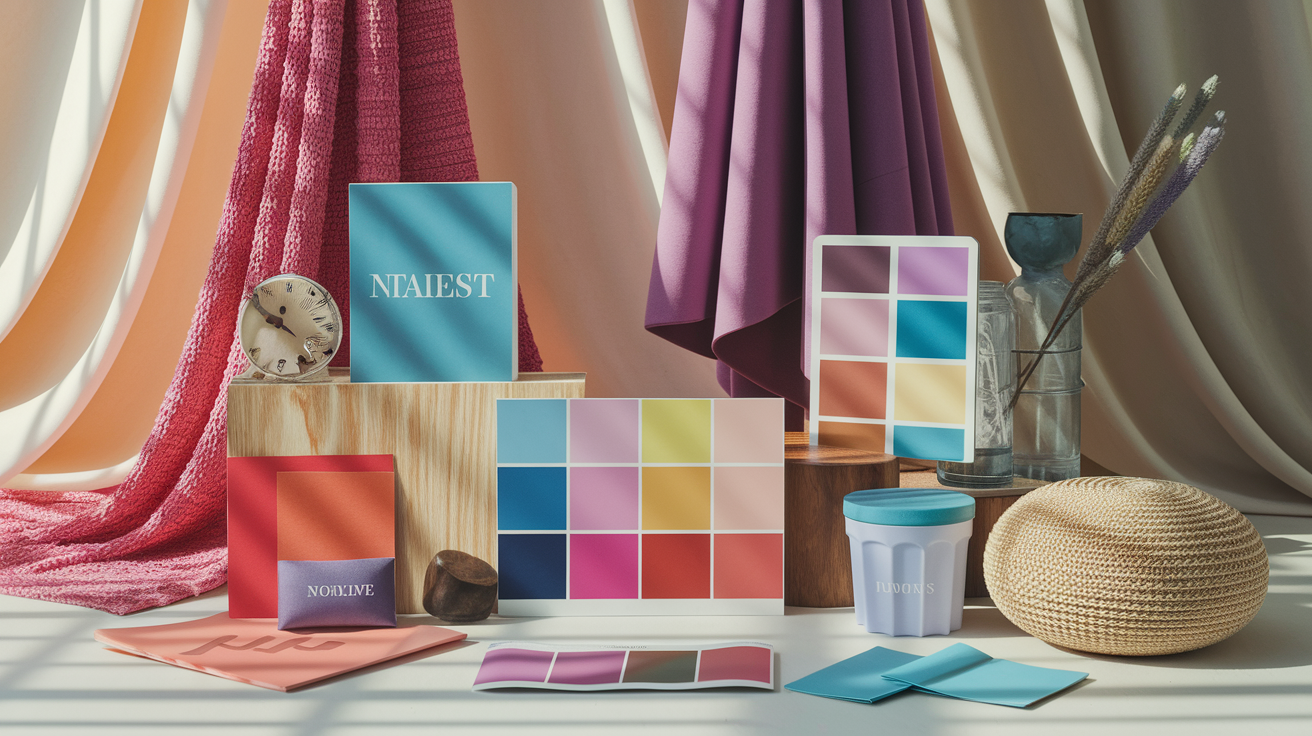
A ten-color palette really pays its rent when it jumps off the screen and onto the hands, and backs, and fronts, and bodies of the world. Treat it like a toolkit: clear roles, flexible pairs, and rules that travel well from pixel to paper to product.
Begin with where it inhabits. For interiors, anchor the room with the 60-30-10 rule: 60% for walls or large surfaces (your calm neutral or soft hue), 30% for furniture or rugs (support color), and 10% for accents like cushions or art (a bold pop). If your palette leans analogous—"friends" on the wheel—use textures to keep it lively: matte paint, woven throws, and a stone vase can tone down extra hues while adding depth.
For fashion, choose a foundational capsule in 2–3 colors, then rotate accent pieces seasonally. A triadic set works well here: think deep blue coat, warm rust knit, and mustard scarf. Lighting changes everything, so swatch test in daylight and warm light—pigments change with material and bulbs.
For branding, establish hierarchy rules so each asset has a sense of belonging. Identify a main duo for logos and headers, a secondary trio for backgrounds and UI states, and a tiny accent group for calls to action or accents. Apply the 60-30-10 split in web pages, pitch decks, and packaging sleeves, so balance remains uniform.
Maintain print and screen in sync by creating CMYK and Pantone matches for every color, and proof on the actual paper stock you'll use. Posters and newsletters benefit from complementary "lovers": pair teal with coral or violet with yellow to grab attention without shouting. Patterns—subtle grids, dots, or line work—can temper strong contrasts and make accent colors feel welcome.
When you map colors from digital, context and substrates make the final determination. A satin box has a different sheen than uncoated card, and fabric dye on cotton prints muted alongside polyester. Create a mini "material board" with paint chips, fabric scraps, and printed swatches under different light at 2,700 K and 6,500 K to catch shifts.
If a color vibrates on LED screens, nudge saturation down and open contrast for readability. Think color theory basics from Newton's 1666 wheel—primary, secondary, tertiary—and select one of the five popular schemes (monochromatic, complementary, analogous, triadic, tetradic) to structure each use case.
Look outward for ideas: sunsets, lichens on stone, city markets, or art movements like Bauhaus or Ukiyo-e can guide tone choices and cultural cues. With palette generators, test mix fast, then tweak by hand so the set still feels human and grounded.
Conclusion
A lean 10 color palette provides definable boundaries and authentic scope. Teams move quickly. Work remains on brand. Here is the thing, people can read and use your stuff pretty easily.
Think in roles, not guessing. Set base, text, link, alert and state colors. Maintain high contrast. Test with a screen reader and contrast tool. Switch a hue, not the entire palette. That's time saving.
Real use is the reality check. A dashboard. A slide deck. It's a product page. If the colors direct the eye and illuminate the important bits, you nailed it. If not, adjust the scale.
Ready to construct? Begin with 1 neutral, 2 brand hues, 2 accents, 5 steps for states. Send your palette to and request comments.
Frequently Asked Questions
What is a 10-color palette used for?
10 color color palette so you have a consistent system going. It accommodates both primary and secondary colors along with neutrals. This is great for branding, UI states, data visualization, and accessibility. It provides sufficient variation without it being overpowering to users or designers.
How do I build a balanced 10-color palette?
Begin with brand / core colors. Include color tints and shades to provide contrast. Add some neutrals for text and surfaces. Try it on light and dark backgrounds. Verify contrast ratios. Take advantage of tools such as HSL, color scales and accessibility checkers.
Why does accessibility matter in color choices?
Convenient color enhances legibility and utility. It assists users with low vision or color blindness. It complies with legal and ethical requirements. Aim for WCAG AA contrast: 4.5:1 for text, 3:1 for large text and UI components.
Can a 10-color palette work for data visualization?
Yes. One major color with nine steps, or multiple colors with distinct contrast. Make sure neighboring colors are contrast-y. Test in grayscale and color-blind modes. Label data as directly as possible.
How do colors influence emotion and brand perception?
Colors communicate mood and purpose. Warm colors can have an energetic feel. Cool colors, for instance, can feel calm. Neutrals bring balance. Of course, always test with your audience – culture means everything. Use color to complement, not substitute for, clear copy.
What are examples of a good 10-color palette structure?
Try: 3 brand hues, 3 accent hues, 3 neutrals, and 1 alert color. Or one base hue x 9 steps + neutral. Keep roles clear: backgrounds, text, borders, states, and data categories.
How can I apply the palette beyond screens?
Apply the palette in print, packaging, environment and merchandise. Turn colors into CMYK and spot colors. Test on actual materials. Test contrast in various lighting. Maintain a style guide for cross-medium consistency.